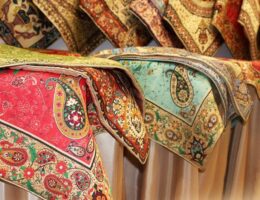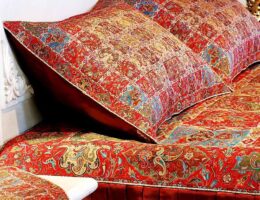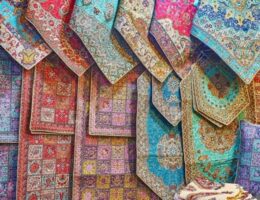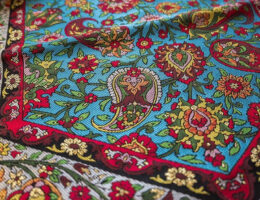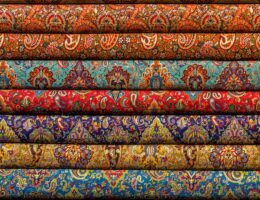IRAN ART EXHIBITION: WHAT IS PERSIAN KHOS-DUZI HANDICRAFT?
The products of Hormozgan handicrafts are mostly created for local purposes. Khos Duzi, a kind of embroidery, is one of them. Khos Duzi consists of sewing thin strips of Khos or Naqdeh on fine and delicate lace fabrics. The strips are arranged to make geometric, cursive, arabesque, “Danehee” and “Kheshti Payeh Boland” motifs and patterns. In addition to lace fabrics, Khos Duzi is applied on velvet, too. To apply the stitches on velvet a kind of needle called “Chenille” is used. The history of Khos Duzi is not known to us, but it is certain that this craft was very popular in Bandar Abbas and Baluchestan during Safavid dynasty. After the Safavid, efforts were made to upgrade this embroidery which led to its products to reach their most beautiful forms.
Khos Duzi is mostly used to decorate lace drapes, lace scarves (Jalbil) and lace Chadors (usually in black), bridal gown, scarves, cover of Holy Quran, trousers, beddings, covers for cushions, head wears, dresses, women vests and many more. The patterns mostly used in Khos Duzi are hexagonal, octagonal and dodecagonal stars. The others include “Noh Khesht”, “Kandoo Asal” or honey comb, “Shesh Ghalb” or six hearts, “Khesht Dar Khesht”, small stars, “Hashieh Barg Anjiri”, “Ghalbi Khali”, “Tak Duzi”, “Por Duzi”, “Gushvareh”, “Naghsh e Gol” or flower, “Gol e Ferferei”, crab or “Kakalehe”, butterfly, scorpion, bowl, peacock, “Hashieh Ghalbi” and “Hashieh Chashm e Gav”. Since the motifs are very simple in this handicraft, there is no need to draw them on the fabric, and the needle worker makes the stitches according to his own taste. Both the front and back of the fabric look the same and look especially shiny. That is in case the work is done delicately and neatly, so that the pattern is created in both sides of the fabric. The threads used in Khos Duzi are golden or silver, and are known as Khos threads. That is the reason this handicraft is known as “Khos Duzi” which means “stitching of the Khos”. Occasionally the artists of this region combine Khos Duzi with other crafts such as Golabatoon and sequins and create unique products.
Hormozgan has good capabilities in the field of handicrafts due to its rich cultural background. The handicrafts in Hormozgan province are mainly seasonal and the reason is the special geographical situation of the region which dictates that the workshops are open and active.
Therefore, in winter and early spring, the production of pottery, wood products, mat weaving and … is very prosperous.
In Hormozgan province, there are ancient rural centers that are interesting in terms of architectural features, physical structure and historical monuments, and most of Hormozgan handicrafts are scattered in these villages.
The most important handicrafts and souvenirs of this southern province can be named as follows: pottery, glabton embroidery, embroidery, shiriki pich, khos (khos) embroidery, with double embroidery, tent weaving, carpet weaving, basket weaving and mat weaving, and mat weaving Sea urchin made from a variety of marine mollusk skins;
IRAN ART EXHIBITION: This type of product is attracted by many visitors to this area due to the beautiful color of Kavk and Mawk hard shells; These handicrafts are mostly consumed locally. According to the researches of handicrafts of Hormozgan province, it can be classified in the following cases: Traditional textures of Hajiabad city is the active center of production of all kinds of traditional textures in which all designs and drawings, geometric and mental, are executed.
Layered carpets, forty mashouleh kilims, needle kilims (shiriki pich), bear weaving and bag weaving are among the most important products of this type of weaving. Marine handicrafts Production of sculptures, paintings, ornaments by shells, corals, marine aquatics is one of the most popular and special handicrafts in Hormozgan province, which is reminiscent of the warm waters of the Persian Gulf and the creative spirit of Hormozgan artists.
The main center of activity of the producers of this industry is Bandar Abbas and Qeshm. Mat weaving is one of the most common handicrafts in Hormozgan province. Mat weaving is produced by women and girls in most villages of the province, especially in Minab villages, and the main weaving material of this product is palm tree.
Types of contla (wicker basket with hanging), gofeh (round and oval fruit basket) and sarjehleh, rug, damkani, fan and… are among the products of mat weaving.
Traditional rudozas Types of rudozis include: weaving, gold weaving, embroidery, and ribbon weaving, the center of production activity of which is Bandar Lengeh city and its dependent villages. Wood Industries The lanyard industry and the wood industry in the surrounding islands and villages indicate the long history of this art in the province.
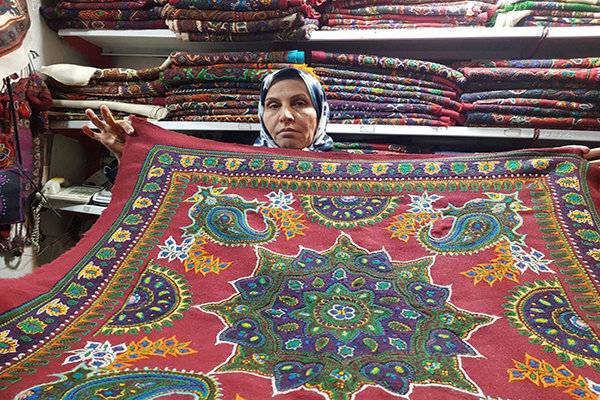
One of the most common products of Hormozgan handicrafts is Khos-duzi, a type of embroidery created for local purposes.
Khos-duzi involves sewing thin strips of Khos or Naqdeh onto fine lace fabrics. The strips are arranged into geometric, cursive, arabesque, ‘Danehee’ and ‘Kheshti Payeh Boland’ motifs and patterns.
Besides lace fabrics, Khos-duzi can also be applied to velvet. Velvet stitches are applied using a type of needle known as a Chenille.
The history of this craft is unknown, but it is certain that this craft was very popular in Bandar Abbas and Baluchestan during the Safavid era (1501-1736).
After the Safavid period, efforts were made to improve this embroidery, resulting in its most beautiful appearance.
Khos-duzi is mainly used for decorating drapes, scarves (Jalbil) and chadors (usually black), lace drapes, scarves, covers for Holy Quran, trousers, bedding, cushion covers, women’s vests, and headwear.
IRAN ART EXHIBITION: The most common patterns in Khos-duzi are hexagonal, octagonal, and dodecagonal stars. The others include honeycomb, stars, hearts, leaves, flowers and brick-designed patterns.
It is not necessary to draw the motifs on the fabric, since the motifs in this handicraft are so simple, and the needleworker makes the stitches according to their taste.
The fabric looks exactly the same both on the front and the back and is particularly shiny if the stitching is done carefully and neatly.
The threads used in Khos-duzi are gold or silver and are known as Khos threads. Therefore, this handicraft is known as ‘Khos-duzi’, which means stitching of the Khos.
Khos-duzi and other crafts such as golabatoon and sequins are often combined by these artists to create unique items.
Known as the province of islands, Hormozgan province is located on the northern coasts of the Persian Gulf. It embraces scenic islands among which Kish, Hormuz, Hengam, and Qeshm are the most beautiful ones and top tourist destinations in southern Iran.

